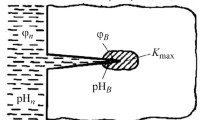Abstract
A computation model of corrosion-fatigue crack growth in thin metallic plates is suggested based on well-known theoretical concepts of fatigue and corrosion fracture and some assumptions. A physicochemical model of this process is constructed, and mathematical relations that describe the kinetics of crack propagation are established. The model agrees with well-known experimental data.
Similar content being viewed by others
References
O. N. Romaniv, S. Ya. Yarema, G. N. Nykyforchyn, et al.,Fatigue and Cyclic Cracking Resistance of Structural Materials, Vol. 4 of: V. V. Panasyuk (editor),Fracture Mechanics and the Strength of Materials. A Handbook [in Russian], Naukova Dumka, Kiev (1990).
V. V. Panasyuk and I. N. Dmytrakh, “Mechanics of corrosion fracture of structural materials,” in:Extended Abstracts of the “Protection-92” Congress [in Russian], Moscow (1992).
H. J. Rätzer-Sheibe, “Repassivation kinetics and anodic oxide growth of titanium and titanium alloys in aqueous electrolytes,” in:Proceedings of the 8th International Congress on Metallic Corrosion, Vol. 1 (1981), pp. 212–218.
A. V. Fishgoit, T. N. Zueva, N. T. Bychkov, and L. F. Kurnosova, “Kinetics of electrolytic hydrogenation of nickel alloys affected by plastic strains,”Fiz.-Khim. Mekh. Mater.,24, No. 3, 42–47 (1988).
A. E. Andreikiv,Spatial Problems in Crack Theory [in Russian], Naukova Dumka, Kiev (1982).
L. N. Petrov,Corrosion under Stresses [in Russian], Vyshcha Shkola, Kiev (1986).
N. P. Zhuk,Corrosion and Protection of Metals [in Russian], Metallurgiya, Moscow (1976).
E. M. Gutman,Mechanochemistry of Metals and Corrosion Protection [in Russian], Metallurgiya, Moscow (1971).
V. V. Panasyuk, A. E. Andreikiv, and O. I. Obukhivskii, “Computation model of crack growth in metals affected by hydrogen,”Fiz.-Khim. Mekh. Mater.,20, No. 3, 3–6 (1984).
V. V. Panasyuk, L. V. Ratych, Yu. I. Zvezdin, et al., “Diagrams of cyclic corrosion cracking resistance of some structural steels,”Fiz.-Khim. Mekh. Mater.,21, No. 3, 37–45 (1985).
Additional information
Karpenko Physicomechanical Institute, Ukrainian Academy of Sciences, L'viv. Translated from Fiziko-Khimicheskaya Mekhanika Materialov, Vol. 30, No. 1, pp. 30–34, January–February, 1994.
Rights and permissions
About this article
Cite this article
Nykyforchyn, H.M., Terlets'ka, Z.O. Computation model of corrosion-fatigue crack growth in thin metallic plates. Mater Sci 30, 25–30 (1995). https://doi.org/10.1007/BF00559012
Received:
Issue Date:
DOI: https://doi.org/10.1007/BF00559012




